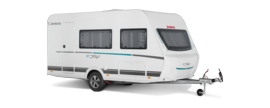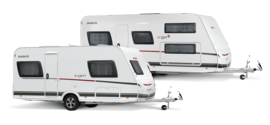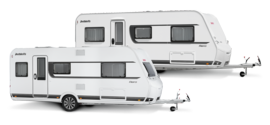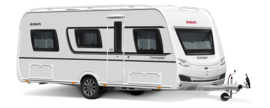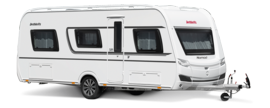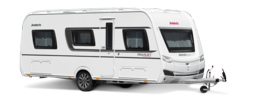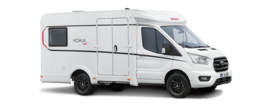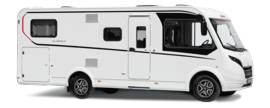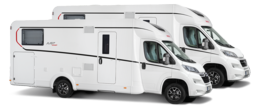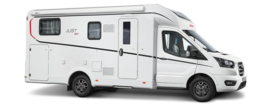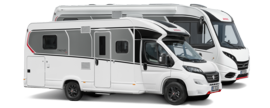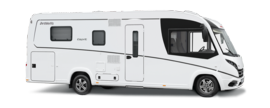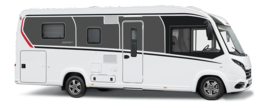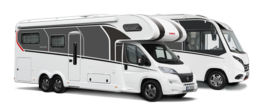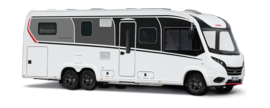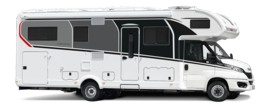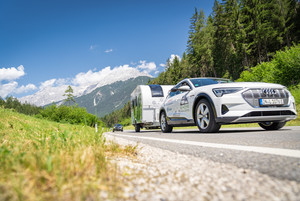E.HOME Alps Challenge
successful practical test for the first caravan with electric drive
Vehicles with an electric drive are currently not an option for caravanners. Due to the additional energy requirement, towing a caravan reduces the range of a battery electric vehicle to less than half, depending on the topog-raphy of the route. The electrically driven E.HOME caravan developed by Dethleffs together with the Erwin Hymer Group and ZF solves this problem. On a demanding caravan tour across the Alps with a prototype, the project partners have now proved that the E.HOME concept is ready for market.
Any caravan owner who has ever made their way across the Alps will be famil-iar with the scenario: The weight and increased drag of the caravan significant-ly increase fuel consumption. Thanks to the short distances between filling stations throughout Europe, this only has a minor influence on journey plan-ning for towing vehicles with a traditional engine. An electric vehicle, on the other hand, will quickly reach its limits on such a journey. Practical tests con-ducted by various trade magazines have shown that even on journeys on less mountainous terrain, towing a caravan quickly halves the range an electric SUV (the only models currently available with a tow bar and caravan-typical towing weights) . When driving across Alpine passes, this figure can be even worse.
E.HOME Alps Challenge – Dethleffs wants to know
“The ranges of the current electric vehicles and the current status of the Euro-pean charging station infrastructure are designed for solo vehicles and do not take into account the requirements of towing operation, for example with a caravan,” explains Dethleffs Managing Director Alexander Leopold. “Dethleffs has always seen itself as a caravanning pioneer. We have therefore identified the challenges of electromobility early on and – together with our partners – are developing solutions that will make this individual way of travelling possi-ble in the future.”
“The E.HOME caravan is an attractive application that we support with our experience and our portfolio for the electrification of all vehicle types,” adds Stephan von Schuckmann, responsible for electrified drive technologies on the ZF board of management. “This corresponds to our claim: ‘We electrify every-thing’. In addition, the electric caravan is an application in which we can fully bring to bear our competence for system integration and comprehensive elec-tric drive solutions, to achieve more efficiency and therefore longer ranges.”
In 2018, caravan manufacturer Dethleffs and its project partners Erwin Hymer Group and ZF Friedrichshafen AG presented a potential solution for the first time: the prototype of a caravan with an electric drive – the E.HOME Caravan.
Following numerous tests and optimisations, Dethleffs have now taken on the ultimate challenge with an upgraded prototype of the E.HOME Caravan: the E.HOME Alps Challenge. The 386 km route from the German Allgäu region across the Brenner Pass to Lake Garda is popular with caravanners and was selected to prove that the electric drive of the E.HOME Caravan can compen-sate for the higher energy consumption caused by towing and that the towing vehicle can achieve its usual range even with a caravan in tow.
Challenging route
Starting at the Dethleffs factory in Isny im Allgäu in Germany, the E.HOME Alps Challenge route first goes to Füssen, then on the Austrian Fern Pass road into the Inntal valley and on the A12 and A13 motorways past Insbruck across the Brenner Pass. In Italy, it continues along the A22 through Bozen and Trento on to Riva on the northern shore of Lake Garda.
Equipped with a number of measuring instruments for analysing the around 800 recorded signals and journey data, the towing vehicle and the E.HOME Caravan set out from the Dethleffs factory in Isny im Allgäu early in the morn-ing. The instruments showed the charging status of the battery packs: 99 per cent for the caravan, 96.4 per cent for the towing vehicle. The E.HOME Alps Challenge Team were looking forward to a roughly 6-hour journey across 386 km.
Anticipation as well as tensions were running high among the team members. After all, three years of development work had gone into this project and would now be put to the test. The route to Riva would have already been a challenge for the towing vehicle without a trailer, as the manufacturer states a range of around 393 km (WLTP) for the selected Audi e-tron, which is only 7 km less than the required distance – in solo operation. But Udo Gillich, project manager for the E.HOME project at ZF, was optimistic: “We are very well pre-pared and have carried out many representative journeys in advance. Based on our calculations and our experience, it should work.”
Added safety with the drive
The first kilometres towards the Fern Pass already showed that the electrically driven caravan influences not only the range, but also the driving feel and safety, according to ZF development engineer Emanuel Pfiffner, who was be-hind the wheel for the E.HOME Alps Challenge: “In contrast to a conventional outfit, you can’n feel much of the load of the trailer. During acceleration, for example when joining a motorway, the towing vehicle does not have to addi-tionally set the mass of the caravan in motion and behaves almost like a solo vehicle thanks to the supporting drive. But during normal driving, the E.HOME outfit is also much more stable and safe to drive, thanks to the lower centre of gravity and the drive. And on downhill stretches or when braking, the cara-van no longer runs towards the vehicle because the outfit is automatically stretched apart to provide a significantly safer driving experience. And this is not only an impression, but can actually be measured.”
At an average speed of 62.3 km/h, the journey continued along motorways and country roads. On motorway stretches, the average speed was between 80 and 84 km/h – quite normal speeds in practical applications. The outfit reached the Fern Pass after 100 km – a little over a quarter of the distance. Accordingly, the charging status was 76.7 per cent for the E.HOME Caravan and 71.2 per cent for the towing vehicle. There was indeed no sign of any ad-ditional battery drain or range reduction due to the trailer. So far, the engi-neers’ predictions had been correct.
Even better yet: At the Brenner Pass, 200 km after the start of the journey and 180 km from the destination, both battery packs still had more than 50 per cent charge, despite a continuous uphill stretch of more than 30 km. Still, the team was becoming increasingly tense, as the E.HOME outfit had to push against a strong headwind from the Brenner Pass onwards, which completely eliminated the advantage gained from the extended downhill section to Bol-zano. Instead of the expected regenerative braking, the drive of the E.HOME Caravan had to push more than once even on the downhill stretch. Then: re-laxed faces 50 km before the destination. More than 20 per cent usable ener-gy remained available in the towing vehicle and almost 18 per cent in the car-avan – enough to safely reach the destination.
Destination reached – with energy remaining in the battery pack
After 6 hours and 12 minutes and 386 km of taxing Alpine roads, the E.HOME car/caravan combination reached the town centre of Riva on Lake Garda – without any recharging along the way. Quite to the contrary: The charging in-dicator even showed some remaining energy in the battery packs of both ve-hicles, which would have been enough for a jaunt to the shores of Lake Garda.
The overall result: 82 kWh of energy consumed by the towing vehicle and 74 kWh by the E.HOME Caravan; 11 kWh of energy regenerated in the towing vehicle and around 6 kWh in the caravan. And beaming faces among the de-velopment engineers of the project partners Dethleffs, Erwin Hymer Group and ZF. Rüdiger Freimann, Head of R&D at EHG, summed it up for everyone: “It is incredible. We have been working on this for three years and have now proven that our idea works. This is just excellent.” Richard Angerer, Head of Development at Dethleffs and ideas provider for the E.HOME project, added: “For me, this is a milestone. The story of Dethleffs began 90 years ago with the invention of the ‘Wohnauto’ caravan and today we have successfully imple-mented an important project for the changing field of mobility. That is an in-credible feeling.”
So Dethleffs and the development partners Erwin Hymer Group and ZF Frie-drichshafen AG have delivered proof: The E.HOME Caravan raises travelling with a caravan to a whole new level. The E.HOME Caravan ensures that cara-vanning holidays with an electric towing vehicle are no longer limited by range while also offering unrestricted driving pleasure with maximum safety.
Perfect solution also for IC engines
The benefit of the electrically driven trailer is not just limited to battery elec-tric towing vehicles, though. The E.HOME Caravan also allows towing vehicles with less powerful internal combustion engines to tow a caravan. The pur-chase of a new car will consequently no longer depend on a maximum re-quirement that only occurs a few times a year. Rather, the vehicle selection can be based on the average requirement, such as the commute, weekend trips or the occasional journey to see friends or relatives. In most cases, this will allow buyers to choose a smaller vehicle category or engine, thereby low-ering the purchasing costs as well as consumption and running costs. This will also have a positive impact on the ecological footprint and make a contribu-tion to protecting the climate.
Dethleffs Managing Director Alexander Leopold: “Although there are still a few hurdles to overcome until we reach production maturity and approval capabil-ity – the E.HOME Caravan developed by Dethleffs, the Erwin Hymer Group and ZF is already a practical and future-proof solution for environmentally friendly and ecologically sensible caravanning for everyone. This once again allows us to prove our claim of being a caravanning pioneer.”
The technology in the E.HOME Caravan
The E.HOME Caravan is designed as a variable, single-axle trailer with its own electric drive. The modular, box-shaped base frame, a drawbar with standard tow hitch and an overrun braking device as well as a central rubber suspen-sion axle allow the caravan superstructure as well as other superstructure types and different superstructure lengths. The positioning of the axle and batteries ensures that the weight of the centrally arranged electric motors and the battery packs is evenly distributed, with the result that the support load and the payload distribution correspond to that of a conventional caravan.
Vehicle frame with crash elements
The requirements for the chassis of the E.HOME Caravan are fundamentally different from those of a conventional caravan chassis. Instead, the design and function resemble that of the chassis for an electric car. The powertrain with the traction battery, the sensor system and the control electronics, wir-ing, hoses and cooling are all housed in the chassis.
The inner frame of the chassis accommodates the battery modules of the drive. The divided design of the traction battery allows for precise balancing of the support load. The outer frame surrounds the inner frame with some gap, offering space for additional drive components such as the inverter, charging unit or control unit and also serves as an installation space for cables and hoses, similar to the intermediate floor in a motorhome. The outer frame also serves as a protection against external influences and accidents. In the rear of the chassis, Dethleffs even integrated a honeycomb crash structure designed to protect the battery packs and other drive components against damage in the event of an impact. For this, the developers took into account crash tests as per automotive standards such as ECE 34 “Prevention of fire risks” for a trailer for the first time. State-of-the-art design methods and simulations en-sure maximum stability of the frame and functional reliability in any driving situation.
Demand-based battery capacity
In the E.HOME Caravan prototype for the E.HOME Alps Challenge, Dethleffs installed two battery modules with around 40 kWh capacity each – one in front of the axle and one behind it. Together, they weigh just under 600 kg. As the results of the E.HOME Alps Challenge prove, such a high battery capacity is enough even for demanding journeys across the Alps. To reduce the addition-al weight of the entire electric drive to under 400 kg, the manufacturer plans to use battery modules with a lower, demand-based capacity for the produc-tion models. With this, Dethleffs accounts for the maximum towing load of current electric cars, which usually ranges between 1,200 and 1,800 kg on the few vehicles that are available with a tow bar.
Just as the chassis, the battery modules also comply with the latest automo-tive standards and therefore with all important international safety standards for electric vehicles.
Thanks to the installed voltage transformer, the traction battery can also sup-ply other consuming units in the superstructure, such as light, a hot water heater or air conditioning. The owner should be aware that using additional consuming units, in particular the air conditioning, can significantly reduce the available capacity for the drive and therefore the range. In camping mode, consumption can be supported by the solar panels on the roof or with a mains connection, which also allows cooking on an electric hob, so gas is no longer required on board.
Charging with maximum 50 kW charging power
In the prototype, the battery packs are charged in the same way as in an elec-tric car – with a wall-mounted charger at home or at a charging station when on the road. The E.HOME Caravan is equipped with a standard type 2 CCS connector for this. AC charging with 7.2 kW charging capacity as well as DC charging with up to 50 kW charging capacity are possible. With an adapter, the E.HOME Caravan can also be charged from a household socket on the 230 V network. With a minimum protection of 10 A, this provides a maximum charg-ing capacity of 2.1 kW. This allows for around 50 kWh of recharging at a campsite in 24 hours, for daily consumption and for the return journey.
Modified rubber suspension axle
For the axle of the E.HOME Caravan, Dethleffs uses proven technology – a ro-bust and durable rubber suspension axle. Some modifications were required, though, to accommodate the drive components. The cranked design of the axle offers sufficient packaging space for central positioning of the drive unit. Output shafts transfer the drive power to the wheels.
Central drive unit with two electric motors
The E.HOME Caravan prototype is driven by a drive unit developed by ZF. It consists of two slightly offset electric motors with 30 kW continuous output each (90 kW maximum output). These are robust 330 V asynchronous ma-chines with a maximum torque of 90 Nm. The two-stage design of the inte-grated gearbox with a gear ratio of 16:1 provides a maximum torque of 1,440 Nm on the wheel. This is sufficient to drive over a four centimetre high kerb, for example. For a potential variant of a future production solution, ZF envi-sions the use of their central high-voltage drive in an axle-parallel design.
As is common for electric vehicles, the electric motors in the E.HOME Caravan can be used as generators in overrun. This means they provide gentle braking when driving downhill while also feeding energy back into the battery to ex-tend the range.
Towing load limitation is the magic phrase
The key to the intelligent drive control of the E.HOME Caravan lies in the ac-tive towing load limitation. In other words, the control unit of the Trailer Mo-bility Control (TMC) feeds in just enough thrust for any driving situation so that a constant towing load is applied to the tow bar at all times. On a level rolling stretch of road, this only requires little drive, and accordingly more on an Alpine pass.
On downhill sections, the trailer pushes and the drive control uses the electric motors as generators to decelerate the trailer while generat-ing energy and feeding it back into the battery pack. Once again the control electronics ensure that the towing load neither exceeds nor falls below the set value. To ensure this, the development engineers equipped the overrun de-vice in the drawbar with a towing load sensor that continuously sends its data to the TMC.
Safer driving with active drive control
The force measurements of the sensor in conjunction with the central control-ler (TMC) allows for a continuous stretching action in the outfit and therefore a permanent improvement of driving safety. The central controller also de-tects transverse forces, for example from crosswind or in corners, and can re-act to these very quickly and precisely – another contribution to more stable driving.
Hydraulic disc brakes as a standard
Even though the service brake is normally not used much, the developers of the E.HOME Caravan make no compromises. As the brake has to generate sig-nificantly higher energy levels during braking than in a classic trailer chassis, a hydraulically actuated disc brake was installed here. As in a passenger car, this can decelerate not only the trailer mass, but also the entire drive power. In addition, the braking force can be dosed very finely in a hydraulic braking sys-tem. Using disc brakes instead of drum brakes additionally ensures low brake fading and consequently reliable braking performance even with repeated braking action. This is an important safety aspect, in particular when crossing the Alps with their long downhill stretches.
The braking system is completed by a mechanical parking brake with automat-ic emergency actuation if the drive electronics or control fail.
Integrated manoeuvre assist with smartphone control
Having a dedicated electric drive on board, as in the E.HOME Caravan, offers additional benefits independently of the towing vehicle. For manoeuvring at the campsite or at home, the drive can be activated and precisely controlled with a smartphone app. This is where the advantages of the drive concept once again come into play. This is because the electronic control not only reg-ulates the drive, but also the steering of the single-axle caravan in tight spaces to allow for exact positioning on the camping pitch – simply by moving the tip of your finger.
Creating a legal basis
The E.HOME Caravan with an electrically driven axle is not yet eligible for type approval according to the current European approval regulations. A vehicle category for “trailers with drive” has not yet been defined. Moreover, the ad-ditional weight of the drive raises additional questions, such as about ac-counting for the weight of the drive components in the permissible towing capacity of the towing vehicle or about the driving license category required for towing driven trailers.
To clarify these questions together with other companies and institutions working in the field of electromobility and to push for the creation of a legal basis for using lectrically driven trailers – not only for caravan applications, the Erwin Hymer Group (EHG) as an E.HOME project partner is actively in-volved in three associations. The Caravaning Industrie Verband e. V. (CIVD) [German Caravanning Industry Association] started an association initiative for e-caravans and is already receiving support from the German Federal Min-istry of Transport and Digital Infrastructure, on whose behalf the German Fed-eral Highway Research Institute – responsible for approval processes – is al-ready planning test drives.
The German Association of the Automotive Industry (VDA), in which the EHG has been active for a few years, is backing trailers with electric drives and brought an initiative to grant type approval for driven trailer axles before the European Commission this year, supported by the European Association of Automotive Suppliers (CLEPA). The EHG is specifically applying for type ap-proval category O2 (trailers between 0.7 and 3.5 t).
In addition, the German Federal Association for Electromobility (BEM) is run-ning an initiative for defining electrically driven trailers (e-trailers) as a sepa-rate vehicle category. Apart from other aspects, the added weight of the elec-tric drive is to be included in the gross weight, for example for determining the driving license category.
